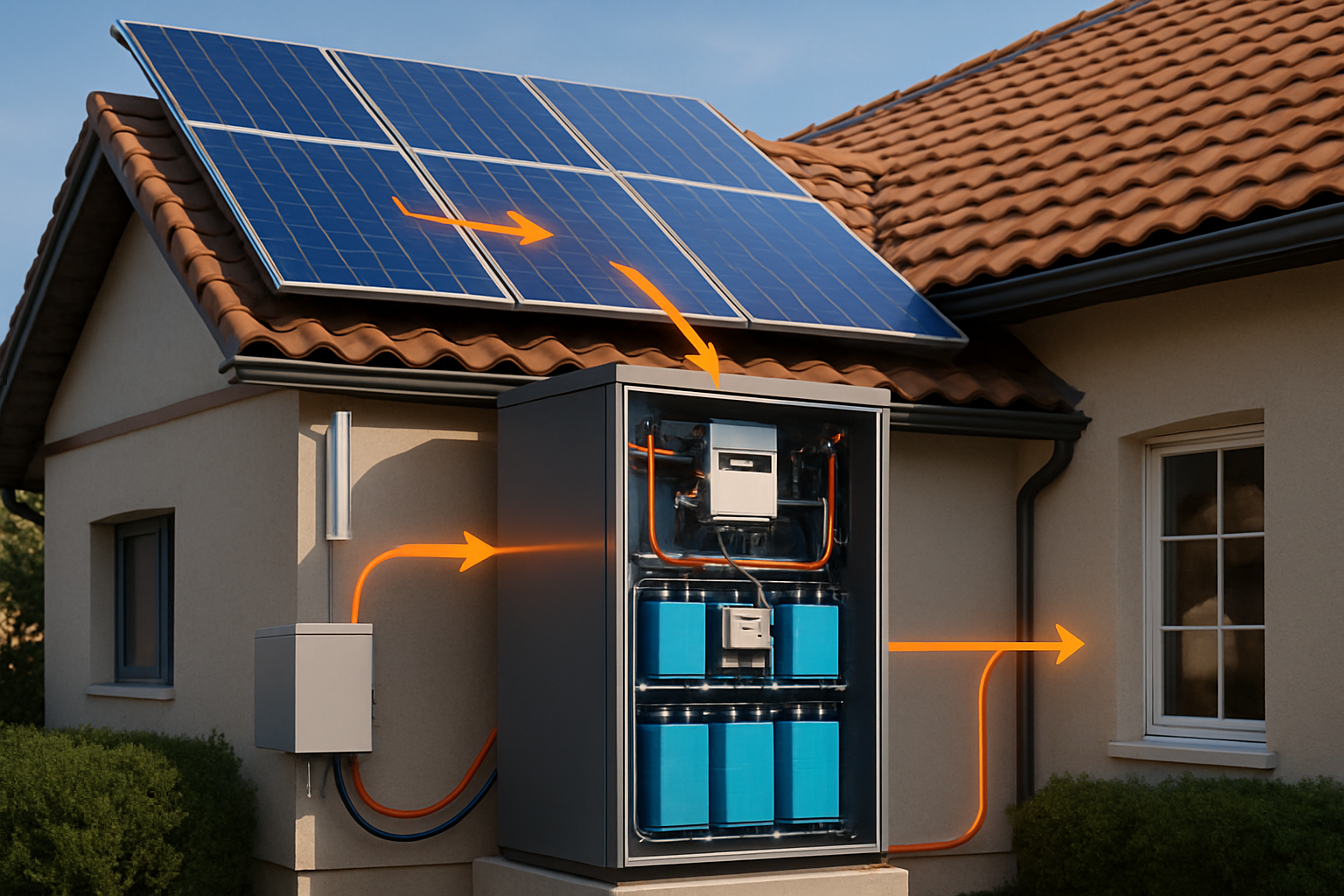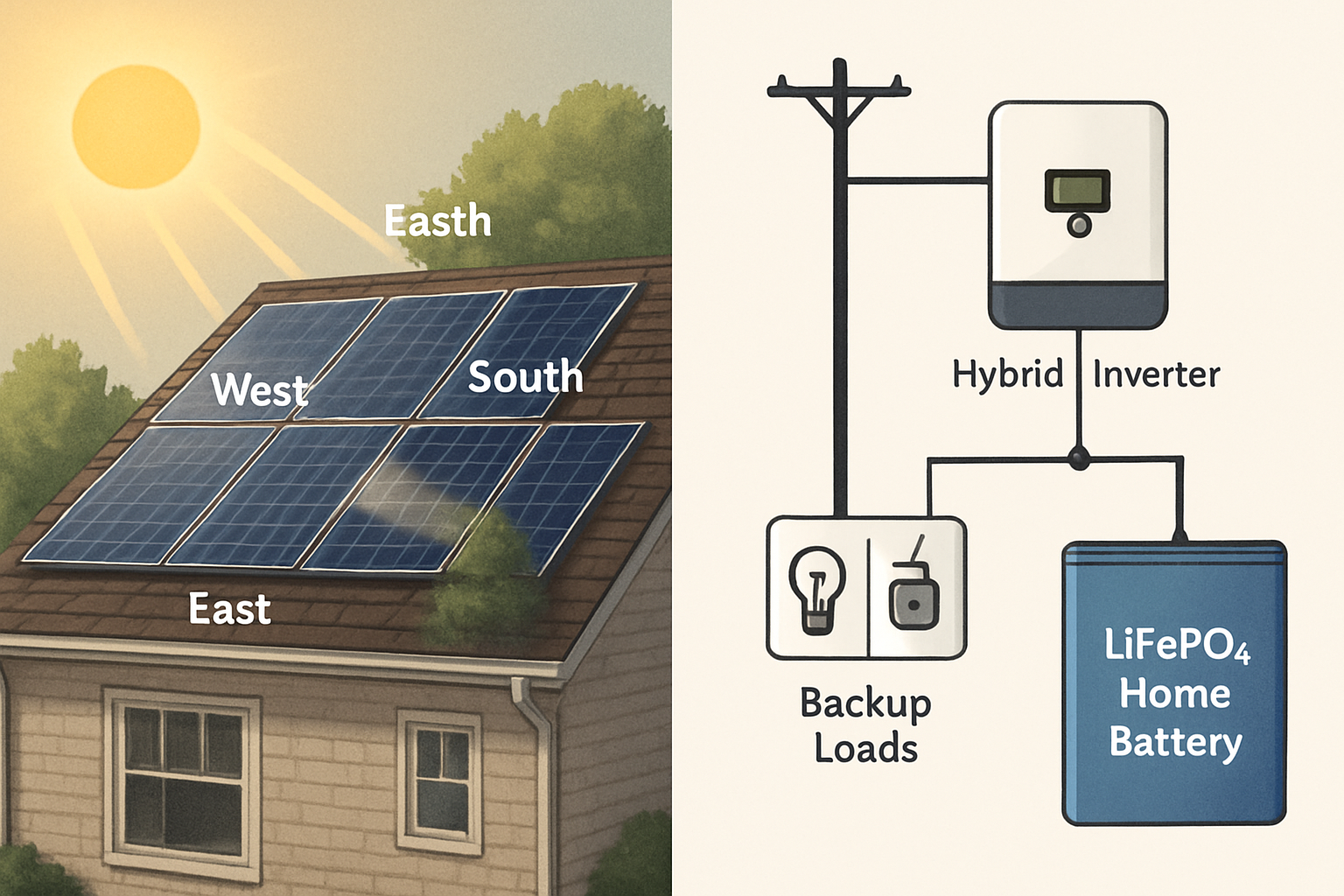Seasonal Solar Performance decides how much your roof can really deliver across the year. Orientation, tilt, snow, and storage shape the outcome. This piece focuses on East–West Solar Array Efficiency, Snow Impact on Solar Yield, and practical checks for Home Solar Suitability.
Solar output follows the sun’s daily and seasonal motion. That pattern is largely predictable. Clouds, fog, and snow add uncertainty on top. According to Getting Wind and Solar onto the Grid, individual PV sites see higher variability than aggregated fleets, yet the daily “bell-shaped” curve remains stable at system scale. The Power of Transformation and Next Generation Wind and Solar Power also note that PV variability is mostly deterministic with a statistical overlay from weather, and that forecast errors grow with snow and fog events.

Seasonal patterns you can count on
Deterministic sun, probabilistic weather
Across latitudes, daylight length and sun height set a strong baseline. Weather moves the scale factor up or down. This framing matches IEA’s view: PV output is the “known shape with an unknown scaling factor” during cloudy or snowy spells, as summarized in Next Generation Wind and Solar Power (Full Report). In plain terms, your array still aims for that arching daytime curve, but storms shrink it.
Capacity factor context
Typical residential PV capacity factor ranges about 10%–25% depending on location and design, per IEA. Winter sun angle, shorter days, and snow push the lower end. Summer boosts it. This swing matters for sizing, self-consumption, and any energy storage pairing.
Load alignment and seasons
In many sunny regions, PV aligns well with daytime demand, as noted in The Power of Transformation. Time-of-use tariffs sharpen this effect. A morning and late-afternoon tilt in output can raise the value of each kWh. That is where East–West layouts shine.
East–West arrays: efficiency, timing, and roof fit
Annual yield vs south-facing
South-facing (north-facing in the southern hemisphere) at tilt near latitude is the classic benchmark for raw annual yield. East–West designs trade a small slice of annual energy for a broader output window. Multiple field studies show that well-designed East–West arrays on flat or low-slope roofs can reach high yield while shifting power to mornings and late afternoons.
| Orientation & tilt | Relative annual yield (kWh/kWp) | Notes |
|---|---|---|
| South-facing, tilt ≈ latitude | 100% (baseline) | Peak around solar noon; highest specific yield at many mid-latitudes |
| East–West, dual-tilt 10°–15° | 92%–98% | Broader morning + afternoon output; reduced midday clipping; ideal on flat roofs |
| Single-plane East or West, tilt ~25°–35° | 84%–92% | Skews output to either morning (East) or afternoon (West) |
| Flat, 5° | 85%–95% | Lower wind load; higher soiling risk if rain is scarce |
Ranges reflect mid-latitudes (~30°–50° N/S) and assume unshaded modules. Actual results vary with climate and roof geometry. The IEA reports above describe the stable daytime shape of PV at system scale, which supports the timing arguments for East–West layouts even if the noon peak is lower.
Why timing often matters more than the last few percent
- Time-of-use tariffs: East–West can better cover shoulder hours, cutting pricier imports.
- Inverter right-sizing: A broader curve reduces midday clipping, allowing tighter DC/AC ratios.
- Appliance scheduling: Morning and late-day loads align more naturally with East–West output.
According to Energy.gov, matching PV output to demand improves self-consumption and bill savings. East–West timing helps with this match.
Snow: mechanisms, impact, and mitigation
How snow changes yield
- Cover loss: Fresh snow can block irradiance until it slides off or melts.
- Albedo gain: Nearby snow can reflect light and add a small boost once modules are clear.
- Forecast risk: IEA notes forecast errors grow during snow or fog, so day-ahead predictions can miss both timing and size of ramps.
Annual impact varies widely. As planning allowances, many cold-climate systems budget a few percent loss in mild winters and higher figures in snowy regions. Site specifics rule.
| Snow climate | Plausible annual loss band | Operational notes |
|---|---|---|
| Mild, occasional snow | ~0%–3% | Sun and tilt usually clear modules within hours or days |
| Moderate snowfall | ~3%–8% | Prolonged cover after storms; albedo can offset a fraction once clear |
| Heavy snowfall region | ~8%–15%+ | Frequent storms, low sun angles; structural and access planning needed |
These bands are planning ranges, not a guarantee. They help shape expectations and O&M strategy. The IEA sources cited highlight how snow raises uncertainty, which is reason enough to allocate buffers in production forecasts.
Design choices that reduce snow losses
- Tilt: A few extra degrees can speed shedding. On flat roofs, dual-tilt East–West at 10°–15° sheds faster than near-flat racks.
- Module layout: Keep lower edge clear of obstructions where snow can pack. Allow safe drainage paths.
- Row spacing: Avoid drift zones that bury the leading row.
- Electronics: Module-level power electronics can recover energy on partially cleared strings.
Safe operations
Avoid risky roof work. Mechanical clearing can crack glass or damage frames. Use professional services if removal is required. Many sites simply wait for sun and thaw cycles.
Turning seasonal insight into a better home design
Quick roof checks
- Orientation window: East through West works. South maximizes noon energy; East–West broadens the day.
- Tilt and structure: Confirm racking angles, snow loads, and attachment according to local code.
- Shading and snow traps: Look for chimneys, parapets, and higher roofs that cast shade or accumulate snow.
According to IRENA, aligning technology choices with resource patterns improves outcomes. This matches the seasonal and diurnal logic explained by the IEA reports.
DC/AC ratio and inverter strategy
- South-facing arrays often justify a moderate DC/AC ratio (for example 1.2–1.4). The noon peak is sharp.
- East–West supports tighter inverters because the curve is flatter. That can save cost without much clipping.
- In snowy regions, allow inverter headroom for sunny, clear-cold days with high irradiance.
Storage pairing: LiFePO4 for seasonal and daily shifts
Storage can raise self-consumption in every season. A 5–15 kWh LiFePO4 battery suits many homes. With East–West PV, the shoulders are stronger, so the battery focuses on evening peaks and outages. EIA data shows demand varies by season; storage smooths those swings on-site. In our product line, LiFePO4 cells, hybrid inverters, and integrated ESS options target reliability and safety for residential use.
Practical comparisons and a worked scenario
Orientation and timing snapshot
| Layout | Typical power shape | Tariff fit |
|---|---|---|
| South, tilt ≈ latitude | Strong midday peak | Good for flat tariffs; may clip at noon under high DC/AC |
| East–West, 10°–15° dual-tilt | Two broad shoulders, lower noon peak | Suited to TOU with morning/evening rates |
| West-facing | Afternoon-biased | Targets late-day peak pricing |
Winter-focused example (illustrative)
Assume a 6 kWp rooftop PV at 40° latitude, clear of shade:
- South-facing baseline winter day: peak 4.2–4.5 kW at noon, total 12–14 kWh/day on a sunny day.
- East–West, dual-tilt: peaks ~2.8–3.2 kW around 10:00 and 15:00, total 11–13 kWh/day on a sunny day.
- Single storm day with snow cover: output near zero until modules shed, then 3–6 kWh late in the day.
Add a 10 kWh LiFePO4 battery:
- Shift 4–6 kWh from late morning to evening loads.
- Keep evening imports low during TOU peaks.
- Provide backup for short outages.
These numbers reflect common field ranges. Actual production will vary with weather and system specifics. As the IEA notes in Getting Wind and Solar onto the Grid, snow and fog can raise forecast errors, so conservative planning is sensible.
Key takeaways for Home Solar Suitability
- Seasonal Solar Performance is predictable enough to design around, based on sun geometry and the “bell-shaped” daily profile described by the IEA.
- East–West Solar Array Efficiency is close to south for annual energy on many roofs, with stronger coverage in morning and late afternoon.
- Snow Impact on Solar Yield varies by site; plan for a loss band and emphasize safe, passive clearing tactics.
- Storage multiplies the value of timing gains, especially under TOU tariffs and in winter.
- Use simple checks: roof azimuth and tilt, structural limits, local snow loads, and an inverter strategy matched to the array shape.
For broader policy and technical context, see IRENA, IEA’s Next Generation Wind and Solar Power, and Energy.gov’s Solar Energy pages.
Closing notes
You can boost yield over the full year by matching layout and operations to the seasons. East–West is a strong choice where timing beats a small energy gap. Design for snow if your climate demands it. Pair PV with a right-sized LiFePO4 ESS to raise self-consumption and resilience.
Disclaimer: Non-legal, non-financial advice. Check local codes, structural limits, tariffs, and safety rules. Work with qualified professionals for design and installation.





Leave a comment
All comments are moderated before being published.
This site is protected by hCaptcha and the hCaptcha Privacy Policy and Terms of Service apply.